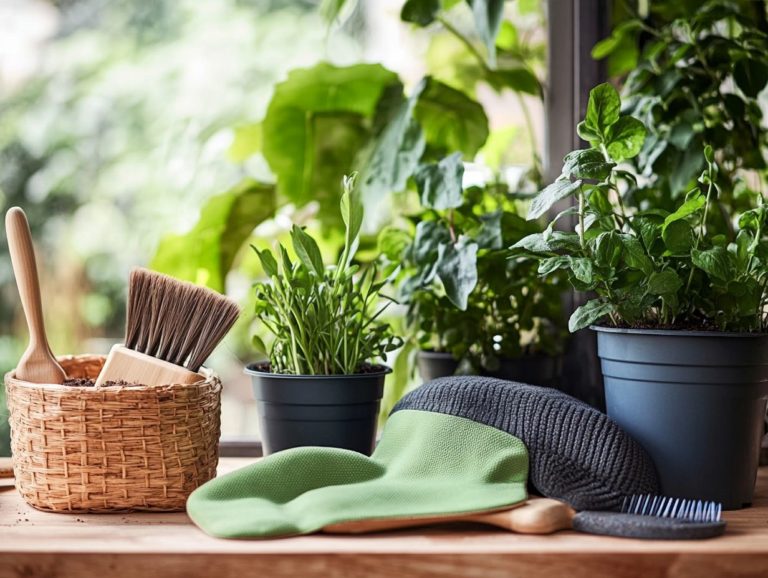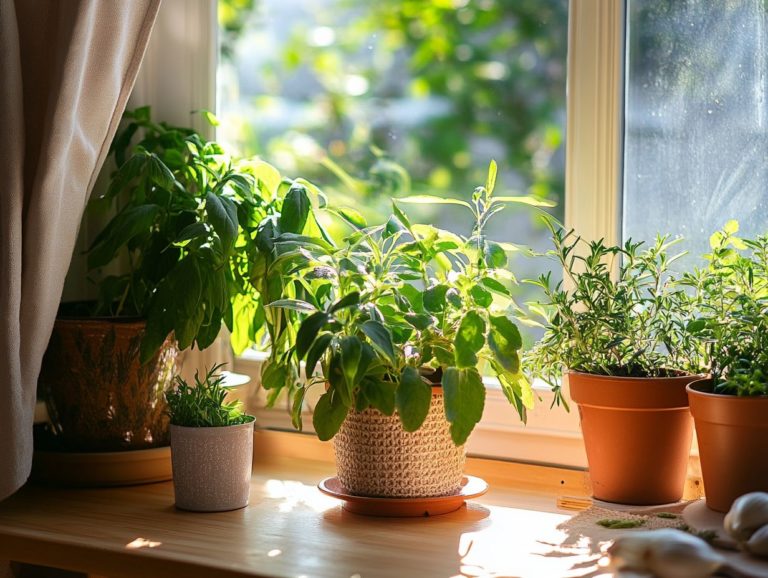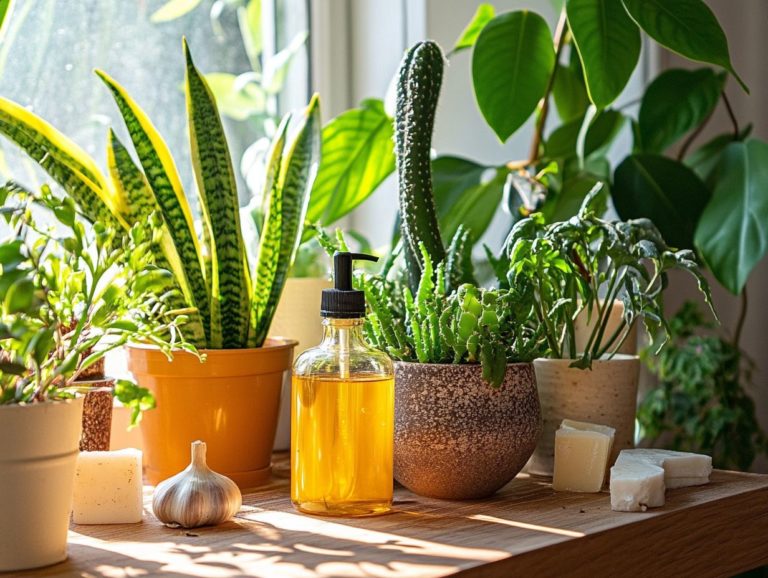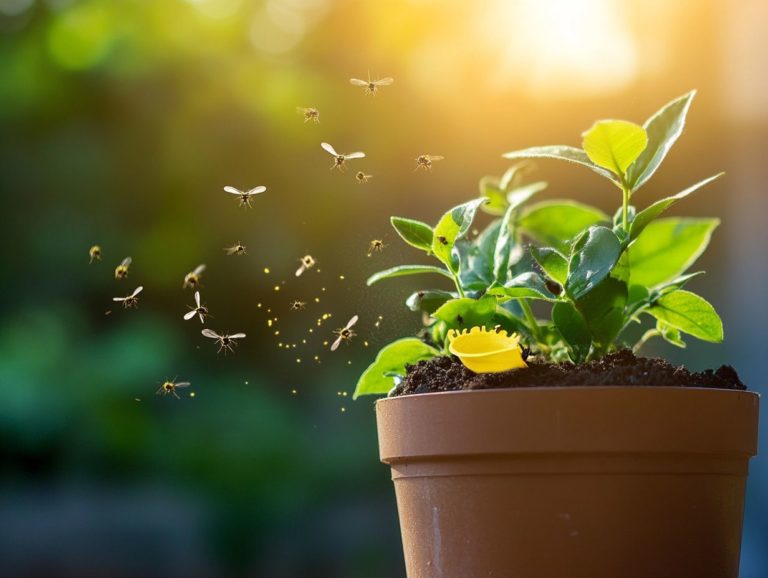Creating a Pest Control Schedule for Plants
Effectively managing pests is essential for ensuring the health and vitality of your plants. This article delves into the various types of pests, their effects on plant life, and how you can create a customized pest control schedule.
You will learn to identify high-risk periods and areas, choose the most suitable pest control methods, and implement preventative measures that promote a thriving environment. From eco-friendly alternatives to regular inspections, this guide equips you with the knowledge to maintain a pest-free garden.
Contents
- Key Takeaways:
- Understanding Pest Control for Plants
- Creating a Pest Control Schedule
- Preventative Measures for Pest Control
- Eco-Friendly Pest Solutions
- Maintaining a Pest-Free Garden
- Frequently Asked Questions
- What is a pest control schedule for plants?
- Why should you care about a pest control schedule?
- How often should a pest control schedule for plants be followed?
- What are some common pest control methods for plants?
- How can I create an effective pest control schedule for my plants?
- What should I do if I notice a pest infestation despite following a schedule?
Key Takeaways:

- Implementing a pest control schedule for plants is essential for maintaining a healthy garden and preventing damage from pests.
- Identify high-risk times and areas in your garden and choose the appropriate pest control methods to effectively manage pest infestations.
- Creating a healthy environment for your plants and utilizing natural and organic pest control methods are key to preventing and managing pest problems in an eco-friendly way.
Understanding Pest Control for Plants
Understanding pest control for your plants is crucial if you aim to cultivate a flourishing garden ecosystem. Effective pest management is not just about using harsh chemicals on your plants; it embraces an Integrated Pest Management (IPM) strategy that combines different methods to manage pests while keeping your garden healthy.
By identifying insects early and implementing effective control measures, you can ensure your plants thrive. This approach also protects beneficial insects and the environment.
Crafting a pest management program requires you to comprehend the pest lifecycle. You must adopt culturally sound practices and integrate diverse gardening strategies that foster a healthy and resilient garden.
Types of Pests and Their Impact on Plants
Various types of pests can significantly impact plant health, leading to considerable damage if you don t address them promptly. Garden pests like aphids, cabbage worms, and slugs often invade your plants, weakening them and reducing their yields.
Animals like deer, woodchucks, mice, and squirrels can also cause damage by feasting on tender seedlings and fruits. Understanding the specific types of insect pests and their preferred habitats is essential for effective pest removal and accurate damage assessment.
On the flip side, beneficial insects play a crucial role in maintaining a healthy ecosystem. For instance, ladybugs and lacewings are your allies in controlling aphid populations, while bees are critical for pollination.
To identify harmful pests, examine your plants for telltale signs of infestation, such as discolored leaves or holes in the foliage. Regular pest scouting allows you to catch problems early, preventing extensive damage.
Utilizing tools like sticky traps or handpicking insects can also help you monitor pest populations and assess their impact on your plant health.
Creating a Pest Control Schedule
Don t wait! Creating a pest control schedule is a game changer for your garden. It gives you the power to anticipate and address pest issues before they escalate.
By setting up a monitoring calendar, you can track pest activity, pinpoint high-risk periods, and establish pest thresholds that indicate when intervention is necessary. Regular inspections allow for early detection, enabling you to apply treatment options promptly.
This includes preventive measures and integrated pest management strategies that prioritize not only the health of your plants but also the well-being of the environment.
Identifying High-Risk Times and Areas
Identifying high-risk times and areas for pest activity is vital for effective pest control. Understanding seasonal patterns and life cycles of garden pests allows you to pinpoint critical moments for timely intervention.
Employ strategies like crop rotation and monitoring pest thresholds to reduce pest issues. This leads to healthier plants and thriving gardens.
Pest behaviors shift based on regional climates and plant types. In warmer regions, pests may show up earlier in spring, while cooler areas might see delays in their activities.
Keep a close eye on your garden’s health. Check leaves for signs of infestation or yellowing to tackle problems before they worsen.
Cultural practices, such as rotating your crops annually, disrupt pest cycles. Healthy soil and a mix of plants support stronger species and create a balanced ecosystem, naturally warding off pests.
Choosing the Right Pest Control Methods

Choosing the right pest control methods is essential for a vibrant garden and effective pest management. Options include chemical treatments, biological control, and organic gardening practices that utilize natural predators.
Understand the pros and cons of each method. Be aware of the potential risks associated with toxic pesticides to prioritize plant health and sustainable gardening.
For example, to combat caterpillar infestations, use Bacillus thuringiensis, a natural bacteria that effectively targets caterpillars while preserving beneficial insects.
Horticultural oils are great for managing pests like aphids and spider mites with minimal environmental risk.
Your choice of method depends on the specific pest, existing conditions, and commitment to eco-friendly practices. Assess the type of infestation carefully to select the best strategy for sustainable growth.
Preventative Measures for Pest Control
Implementing preventative measures for pest control is vital in creating a resilient garden ecosystem. These measures effectively minimize pest impact through preventive treatment.
Embrace cultural practices like companion planting, crop rotation, and choosing resistant varieties. These strategies diversify your garden while enhancing pest resistance and supporting beneficial insects.
Integrating preventive treatments like water sprays and careful garden maintenance deterrents pests before they can escalate, boosting your pest monitoring efforts.
Creating a Healthy Environment for Plants
A healthy environment is crucial for your plants. It helps prevent pest infestations and ensures your garden flourishes.
By implementing effective maintenance practices like proper watering, soil management, and pest exclusion techniques you nurture robust plant health.
Embracing garden diversity by cultivating various plant species fosters a balanced ecosystem. This supports beneficial organisms and keeps harmful pests at bay.
Inviting beneficial insects and a variety of plant life into your garden enhances pollination. It also establishes natural pest control mechanisms.
Regular soil testing and amending with organic matter dramatically improve soil structure and nutrient availability. This promotes strong root development.
Adopting efficient watering strategies, such as a method that delivers water directly to the plant roots, saves water and minimizes the risk of fungal diseases from overwatering.
Consistent maintenance routines help you monitor plant health. You can then address potential issues promptly, ensuring a resilient and thriving garden that leads to bountiful harvests.
Using Natural and Organic Pest Control Methods
Embracing natural and organic pest control methods is a superb choice for those who prioritize sustainability and environmental health.
These techniques safeguard your plants and champion biodiversity. They minimize adverse effects on beneficial insects and wildlife.
By cultivating a balanced ecosystem, you enhance your garden’s natural defenses against pests. For example, introducing predatory insects like lacewings or parasitic wasps can dramatically reduce aphid populations.
Utilizing organic pesticides derived from plant oils or fermented substances allows you to target specific pests. This approach does not disturb surrounding flora and fauna.
These methods align beautifully with sustainable gardening principles, fostering a vibrant and thriving environment brimming with life.
Eco-Friendly Pest Solutions
Addressing pests in an eco-friendly manner is vital for sustainable gardening and for protecting beneficial organisms.
Implementing environmentally responsible pest management strategies allows you to effectively eradicate pests while reducing your ecological footprint.
Using tools like a monitoring calendar, alongside efficient pest removal techniques, helps you manage pests without harming your garden ecosystem.
Alternative Pest Control Methods

Exploring alternative pest control methods offers effective solutions that reduce reliance on chemical treatments.
Techniques such as pest traps, water sprays, and attracting natural predators not only manage pest populations but also enhance biodiversity in your garden.
For instance, introducing ladybugs significantly cuts down aphid populations. Setting up insect hotels can draw in both pollinators and predators.
Companion planting is another strategic tactic; certain plants deter unwanted pests or attract beneficial insects, fortifying your garden’s resilience.
Integrating these methods into a cohesive pest management strategy complements traditional approaches. This includes targeted pesticide application while fostering a healthier environment.
By blending these practices thoughtfully, you can achieve sustainable results. This promotes a thriving ecosystem and avoids overreliance on chemical interventions.
Maintaining a Pest-Free Garden
To maintain a pest-free garden, embrace diligence and a proactive mindset. Engage in regular inspections and meticulous garden upkeep.
By monitoring for potential pest issues, you can catch problems early. This allows for swift pest removal and an accurate assessment of any damage.
Integrating consistent maintenance routines, like checking for signs of infestation and employing effective pest monitoring techniques, enhances your chances of lasting success in your garden. Additionally, understanding how to create a light schedule for plants can further support healthy growth.
Regular Inspections and Maintenance
Regular inspections and maintenance are vital! They help you catch pest problems before they become serious. By scheduling routine checks and implementing effective methods to monitor pests, you can ensure that preventive treatments are applied at the best times, significantly enhancing your garden’s overall health.
Make it a priority to inspect your plants regularly for any signs of trouble, such as discolored leaves, unusual spots, or visible pests. It’s also crucial to keep an eye on soil health and moisture levels. Both dry and overly wet conditions can attract harmful insects. Implementing a pest monitoring plan can help you manage these issues effectively.
Establish a maintenance schedule perhaps by marking dates on a calendar to stay proactive. Keeping a log of these inspections lets you track patterns over time, making timely interventions easier. For effective care, consider how to create a watering schedule for your plants. With diligent monitoring and preventive treatments, your garden can maintain its beauty while developing the strength to withstand pest challenges.
Frequently Asked Questions
What is a pest control schedule for plants?
A pest control schedule for plants is a plan that outlines specific actions to prevent or manage pest infestations. It includes regular inspections, monitoring, and treatment methods to keep your plants healthy and safe from harmful pests.
Why should you care about a pest control schedule?

A pest control schedule is important because pests can cause significant damage to plants, leading to loss of yield or even death. By having a schedule in place, you can proactively prevent and manage infestations, ensuring the health and productivity of your plants.
How often should a pest control schedule for plants be followed?
The frequency of a pest control schedule depends on various factors, such as the type of plants and the severity of pest issues. Typically, it’s recommended to follow the schedule at least once a week or as needed based on your observations.
What are some common pest control methods for plants?
Common pest control methods include using natural predators like ladybugs to eat harmful insects, applying pesticides specifically designed for plants, and implementing cultural practices like crop rotation and pruning to prevent infestations.
How can I create an effective pest control schedule for my plants?
To create an effective pest control schedule, first identify the types of pests that often affect your plants and research effective control methods. Then, develop a plan that includes regular monitoring, prevention measures, and treatment methods to keep pests at bay.
What should I do if I notice a pest infestation despite following a schedule?
If you notice a pest infestation despite following your pest control schedule, act quickly! Consult with a professional gardener or pest control expert to determine the best course of action. Make sure to adjust your schedule and methods to prevent future infestations.






